With some sadness I read the obituary of Duffy Ayers in The Guardian. Here is a link the piece by Mel Gooding.
Tag: Art
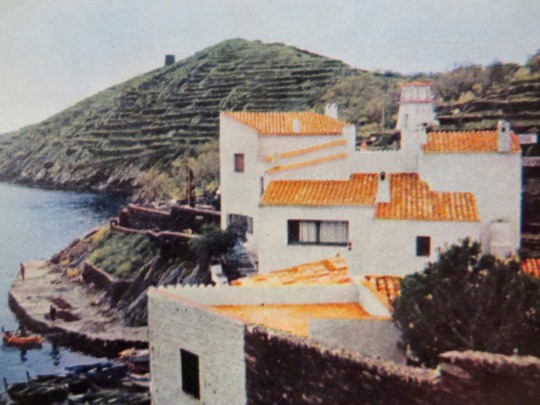
When I married Salvador Dali his moustache was. no bigger than a thread of silk,’ his wife Gala explains. ‘We lived in a one-roomed fisherman’s hut overlooking Port Lligat in Spain, and while I learned to fish and prepare lobsters à l’espagnole,
Dali struggled with surrealist paintings. Every six months both of them went to Paris and tried to sell his work. Today he places commissions on a three-year waiting list, and intimidates the world with a moustache capable of anything from a heavily waxed coil to a vertical sword thrust. ‘Sometimes,’ Mrs. Dali admits, ‘I worry in case he scratches his eyes out.’
The fisherman’s hut, too, has grown. ‘Our Hamlet’ is the way Mr. Dali describes it. Apart from three cottages and a rather new-looking hotel, Port Lligat is the Dali home. One by one, neighbouring cottages and outhouses have been given an extra storey, whitewashed, and added to the home structure. The result is a nest of twelve different roof levels set between terraced hills, with a tiny bay and four rowing boats just six steps down from the front door.
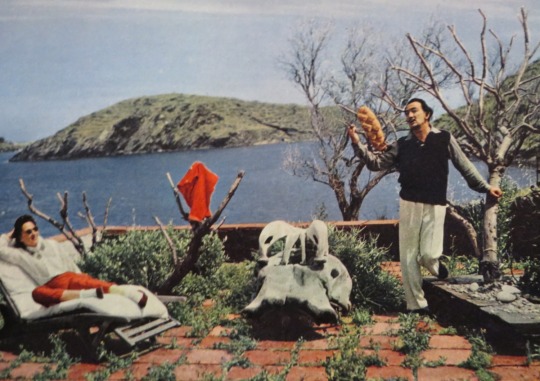
‘I still go fishing.’ says Mrs. Dali, ‘but the boats are fitted with motors now, and I no longer have to prepare the meal afterwards.’
She trained a staff of three–manservant-cum-chauffeur, chambermaid, and cook-to run the ten-roamed house so that she could deal with her own work as secretary, artist‘s model (she is the dark-haired beauty in most of his paintings), and keeper of the Great Privacy. ‘I arrange for us to have no telephone and no guest room,‘ she says with obvious satisfaction. ‘Visitors either come by yacht and sleep on board; or they take our mountain road, which is not good, and sleep at the hotel.’
In fact, the last stretch of road is so bad that the Dali Cadillac has to have a house and garden of its own in nearby Cadaques. ‘We complete our journey by local taxi, which is like riding a mountain goat.’
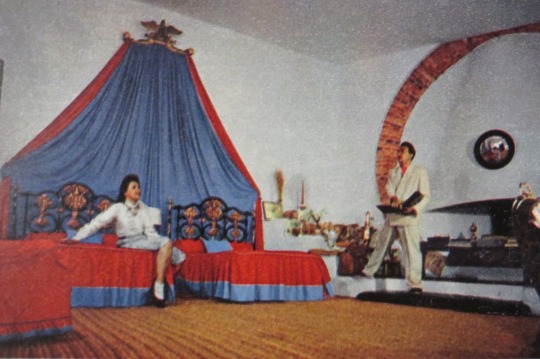
‘Cosmic inspiration’
In spite of their inaccessibility and a wish to safeguard privacy, the Dalis are not inhospitable, and friends are always welcome-after eight o’clock in the evening. ‘For six months of the year we live in American hotels,’ Salvador Dali explains. ‘I make big appearance for public and friends. I design nightclubs, create fantastic Dali parties. Port Lligat is secret place, where I was little boy, where I work always. I bring strong cosmic forces back from America, Gala brings canvas and brushes, and I paint in studio.’
He is now working on the Greatest Dali Masterpiece, a religious canvas over twelve feet high and nine feet wide. By using pulleys and a slot in the studio floor which opens on to cellars below, he is able to adjust the canvas to any working height or whisk it out of sight altogether. He hopes he can complete the work within six months. He then has fifteen commissioned portraits to paint-at an average fee of £7,000 for each one. ‘Money itself does not interest,’ he says. ‘Only the symbol is very strong in me.’
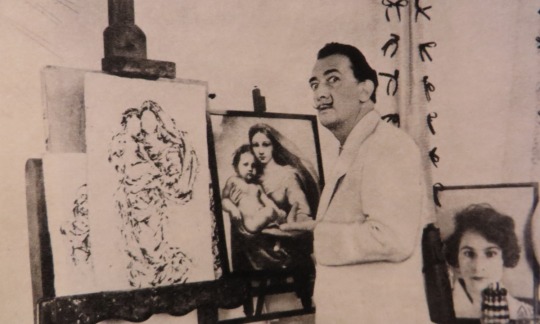
The studio, like the bedroom and the main sitting room, has a sloping, heavily beamed ceiling, and everything is distempered white. No artistic mess or muddle here, only a deliberate and persistent study in contrast. A life-size Apollo, for example, sporting a Davy Crockett hat ‘to keep the mind sparking’; a jewelled casket balanced on a tripod of French loaves.
‘Bread is obsession,’ he explains. ‘It captures many shapes for me. Like sea urchin which has cosmic inspiration, and rhinoceros for strong fear. I learn secret and use in my work.’
He has just completed a film (to be shown at the next Cannes Festival) which tells the story of his strange philosophy. It took him two years to make and he calls it The Prodigious History of the Rhinoceros and the Lawmaker.
These obsessions also play a decorative and oddly formal part in the home. Each room holds at least one secret. The main lounge, predominantly white with yellow upholstery and a floor of polished bricks, has two stuffed swans perched on the ‘canopy’ of books which divides the room; the entrance hall is furnished with a life-size bear wearing elaborate chains of office, and a couch inspired by the line of Mae West’s lips.
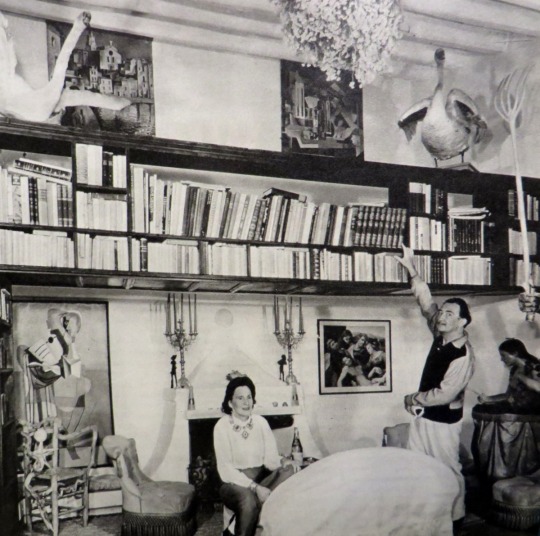
The bookcase has two stuffed swans looking down on the room.
The rooms themselves vary in size and shape, and they are all built on different levels. Most impressive is the hundred and-fourteen feet long, three-tiered bedroom, consisting of lower Sitting room with yellow pin-cushion settees, curio landing seven stairs up, decorated with elaborate jars of sugared almonds, and the bedroom proper seven steps above that. This has a red and blue canopy for the two divans, and a large fireplace with a walled-in sitting recess inspired by one of Dali’s sketches.
All the fireplaces at Port Lligat are based on designs by Salvador Dali, but Gala is the one who chooses the furniture and decides on the decor. Her approach is simple and effective. ‘A house must be warm,’ she says, ‘it must also be nourishing for the mind.’ She guards against the strong mountain wind (Lligat is on the East Coast some forty miles south of the French border) with central heating. She keeps the house ‘alive’ with hundreds of well-thumbed books, and a retinue of comfortable animals: she has white canaries in her bedroom, cats downstairs, and pigeons in a vast pagoda-style dovecote outside.
Although she is Russian by birth and international by upbringing, Mrs. Dali’s choice of furniture is mainly local. For the dining room she has fifteenth-century refectory~style pieces from a nearby monastery; she bought, and dismantled, a vintage black and gold Catalan bedstead to make headboards for the divans.
‘Silk and brocade is right for town,’ she says. ‘Here we need crisp white linen curtains. On the floor I have rush matting used for covering the local ox wagons.’ A samovar is her one concession to the past, but even this comes in useful on chilly evenings.
By mutual consent, Time, in the shape of a mad rococo clock, is firmly relegated to a decorative comer of the rock garden outside. They nevertheless follow a routine of work, breakfast, work-swim, work-siesta, and work which is governed in detail by the light, and Salvador Dali himself-self-acclaimed genius. ‘I am. fifty three,’ he says, ‘but even as a boy I paint With originality. Two times they expel me from college,
I am so good.’ He had a tempestuous school career at Figueras, twenty miles from Lligat, and his parents weathered his ‘Stone Period‘ with desperate patience. ‘I painted stones and tied them to‘ canvas,’ he says. Unfortunately, they were rarely secure, and his father would explain the noise to startled visitors: ‘It‘s nothing, just another stone that’s dropped from our child’s sky.’ Later he went to art school in Madrid, and on to Paris where he found the centre of surrealism and a fascinating but meagre living.
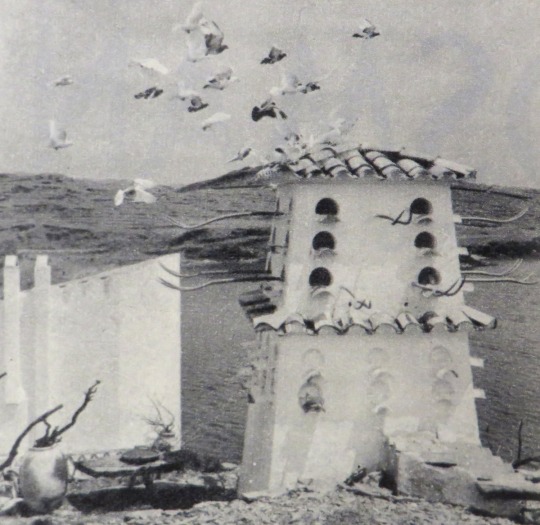
Pagoda-style dovecote decorated with pitchfork perches – is home to a hundred pigeons, and also an extension to the Dali game larder.
During one of his many return visits to Spain, he met Gala on holiday, courted her in French, and proposed with ninety red roses which he could ill afford. Encouraged by his wife, he clinched his reputation in Paris with some of his most brilliant work. and in 1935 decided to take a one-man show to America. The Dalis arrived in New York with thirty pieces of luggage, and the world’s biggest loaf for dramatic effect.
The loaf was ignored, but the paintings, were a fabulous success, particularly his portrait of Gala balancing a pair of chops on her shoulders. Questioned about significance, he replied: ‘I like Gala, also chops.’
At home he has always been quietly spoken and unexpectedly modest. Dark-haired and dark-skinned, he is an expert showman who delights in dressing up. He has an extensive ‘Spanish’ wardrobe, although most of his fancy Catalan shirts are in fact cowboy ones, bought from drugstores in America, and modified at home. ‘
“During the day I wear knee-length trousers; in the evening I always have them full length. She has dozens of pairs, mostly skin tight and all couturier-made.
The Dalis have one luxury bathroom with an excellent supply of hot and cold rain water, but mineral water is Gala’s great personal extravagance. ‘We buy it in bottles for cooking, but I use it for washing as well.’
The menu at Port Lligat is governed by Mr. Dali’s standards, ‘Food must have well-defined shape, so intelligence can grasp it,’ he says. ‘Shell fish and chop is good. Spinach bad.’ A weekly delivery of food supplies from Figueras is augmented by local fish, rabbits, and the famous Dali pigeons.
The kitchen, decorated with exhibition posters and presentation plaques, has an electric ’fridge (run off their own power plant) and an Open range for cooking, because the staff prefers to use charcoal. Life with Salvador is remote from local custom, but he does create fiestas of his own. He will organize a firework display for the fishermen and their children to celebrate the completion of a new work.
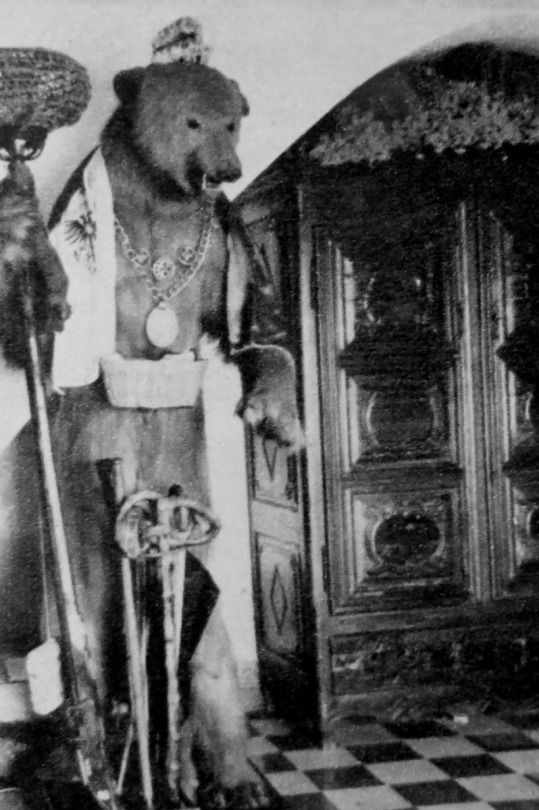
The bear in the hallway holds a lamp-stand and a basket for gloves.
He recently bought a barn in Cadaques which he plans to convert into a private cinema for Chaplin films and Dali premieres. He spends most of his evenings writing at home (he is working on his third book), but occasionally the local choir is invited for ‘champagne and songs’. In return, they bring gifts of fragrant herbs for the house. ‘They love Dali,’ his wife comments, ‘and understand him a little.’ Certainly they would have appreciated the way Freud described him after their one and only meeting: ‘I have never seen a more complete example of a Spaniard. What a fanatic!’

Lyons Print: William Scott — The Bird Cage.
The war had not only hit at Britain’s cities with bombs, but also at the people with rationing. Food and fabric, paper and paint, tea and sugar were all rationed.
It was in the war years that the Lyons teashops became shabby and as fashions started to change in the post war era they looked dated. Materials like wood and paint where mostly reserved and rationed for government use in the post war construction, so another idea had to be devised to make the Lyons tearooms look more respectable.
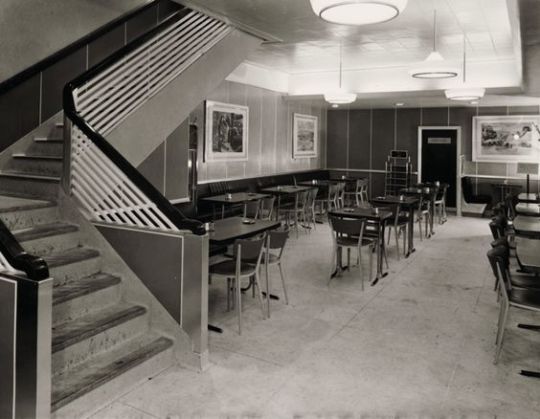
Lyons Teahouse. 1951 The 2nd series of lithographs on the walls.
The directors, Felix and Julian Salmon had the idea of refreshing the tearooms with lithographic pictures to make them more appealing. In 1947 they sort advice from Jack Beddington who was the Artistic Director of Shell-Mex.

Shell Advert by Tristram Hillier — White Cliffs of Dover
The advertising in the 1930’s for Shell-Mex featured British artists modern work with simple text. It had been a public success and an exhibition of the Shell-Mex lithographs in 1939 was well attended.
The art of advertising in London from the mid 1920’s onward had seen modern art projected onto the public with company’s like Shell-Mex & London Transport using artists like Paul Nash, Edward McKnight Kauffer, Horace Taylor and Graham Sutherland to illustrate bold and simple posters.
It was an age when galleries charged admission and in the war years galleries where disbanding and hiding their art collections safe from German bombing raids. This would mean that the colour advertising posters where some of the few artworks to be left open to the public in wartime and where displayed all over the country. It would be the first time the public would encounter these artists.
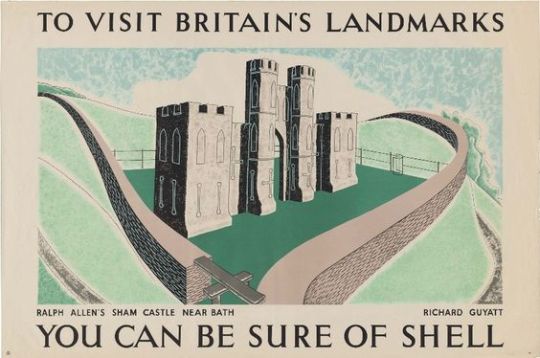
Shell Advert by Richard Guyatt — Ralph Allen’s Sham Caster nr Bath.
By appointing Beddinton they relied on his contacts with artists to product the lithographs. Samples and designs where commissioned and the first series of these sixteen prints featured Edward Ardizzone, Edward Bawden, Clifford & Rosemary Ellis, Barnett Freedman (who assisted with artistic advice on lithography) Duncan Grant, Edwin La Dell, John Nash to name half. Artists also claimed royalties on copies sold in the tearooms, an unusual practice in it’s day. One thousand five hundred prints where made of each poster in the first series.
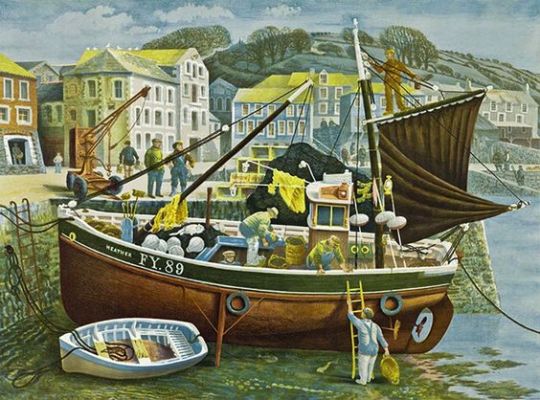
Lyons Print: David Gentleman — Cornish Pilchard Boat
Some of the troubles in printing came from printing trade unions and of artists unfamiliar with the lithography process. Some of these posters had to be hand drawn onto the lithographic plate to be printed, pre-made works where translated from paintings by Chromoworks Ltd, London.
The artworks for Lyons had a press release in 1947 at the Trocadero Restaurant, London, where Lyons often had their board meetings.
A special preview was arranged for Queen Mary.
Many prints where glued to wood or mirrors for hanging in the tearooms, the public could then buy the posters un-mounted and unframed, it’s the prints unglued to canvas and board that are worth more money today.
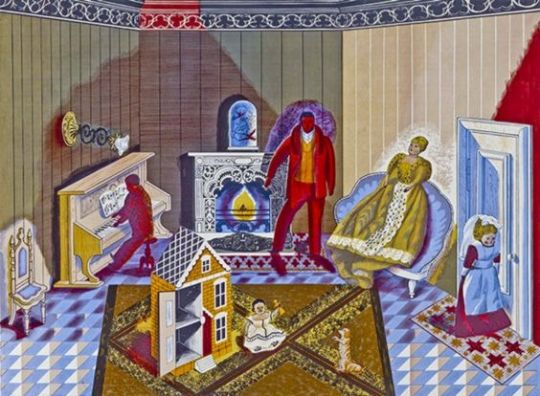
Edward Bawden — The Dolls at Home.
Thirty of the Lyon’s Tea Rooms in London exhibited the prints at first. Due to the press and public interest the prints were soon found in all Lyons’ teashops. The success of the first series of prints meant that a second and third series of prints came in 1951 and 1955.
It is worth noting that companies like Guinness started to produce lithographic prints (The World Record Series) to brighten up their pubs soon after. So the series and it’s publicity had an ongoing effect.
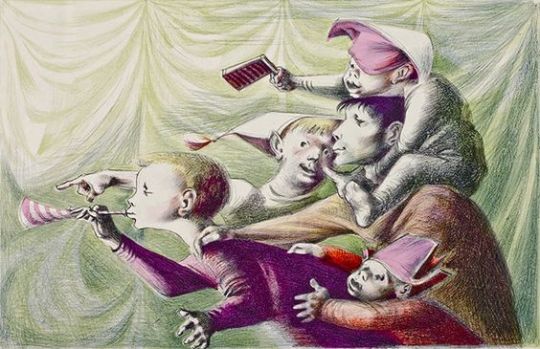
Michael Ayrton — The Spectators
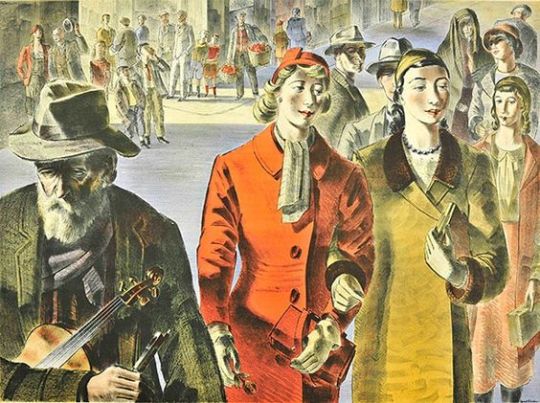
Barnett Freedman — People
from The Guardian, May 7th 2007.

A woman of great beauty and personal magnetism, Angelica Garnett, who has died aged 93, had many gifts. She turned her hand to mosaics, painting and sculpture and transformed domestic interiors with hand-painted decorations. As a writer, she used words with great sensitivity and precision. Her speaking voice was startlingly beautiful owing to her exquisite pronunciation. Her creativity must have been partly genetic, for she was the daughter of the artists Vanessa Bell and Duncan Grant, a parentage that gave her a double share of Bloomsbury inheritance.
This proved to be both a blessing and a burden. During much of her life, and particularly in the essays and books that she wrote, she struggled to come to terms with the psychological complexities that she associated with her upbringing. Her difficulties and anger with her elders emerged in her memoir Deceived With Kindness (1984), which contributed a poignant coda to the history of Bloomsbury and triggered a fresh spate of antagonism towards it.
To some extent, Angelica shared this negative view, while, at the same time, remaining a principal exponent of Bloomsbury, its values and way of life. Listening to her speak in public about herself and Bloomsbury, it was distressing to witness the tension between her pride in her forebears and the pain that these memories caused.
Her mother often reminded Angelica that she had French blood in her veins, for her great-great-grandmother had been married to the Chevalier de l’Etang, a member of Marie Antoinette’s household. But it hardly needed this distant connection to stimulate the young girl’s interest in all things French, including art. In her childhood, there were long periods spent in the south, mostly in a small villa outside Cassis.
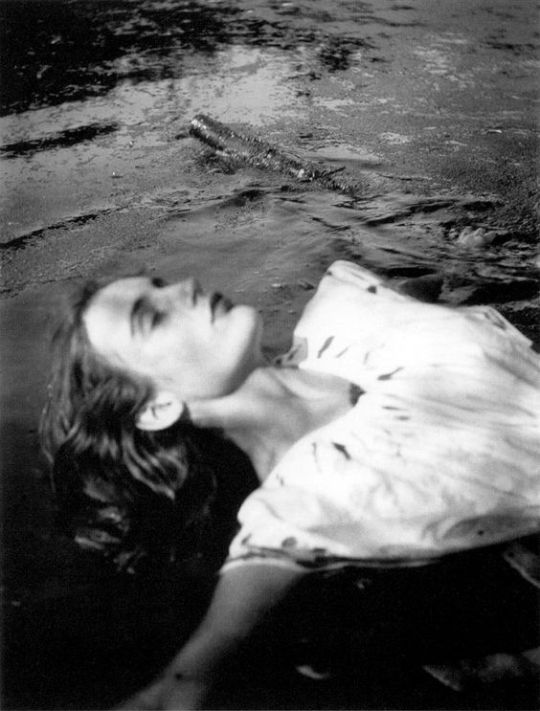
When she was 18, she was sent to live for a while with a family in Paris so that she could learn the language. In old age she observed that her life had been “loosely and pervasively mixed up with France for as long as I can remember” and that “nothing in it would be the same or have the same flavour without this connection”. The country eventually became her permanent home and her last 30 years were spent living in Forcalquier.
She had been born at Charleston, a Sussex farmhouse situated at the foot of the South Downs and at some remove from the nearby village of Firle. Nowadays visitors stream through the house, during the six months of the year that it is open to the public, but at the time of Angelica’s birth it was remote from civilisation and devoid of modern comforts. Vanessa Bell had rented it so that Grant and his friend David Garnett, both conscientious objectors, could obtain necessary employment as farm labourers. Her husband Clive Bell visited at weekends, but marital relations between them had ceased and Vanessa had fallen in love with Grant. He returned her love, despite the fact that he was predominantly homosexual.
Knowing this, Vanessa agreed that the good-looking Garnett, with whom Grant became obsessed around 1914, could become part of their wartime menage. Soon after Angelica was born, she was weighed in a shoebox on the kitchen scales. Garnett, watching the procedure, was astonished that the baby already showed signs of intelligence and independent will. He wrote presciently to Lytton Strachey: “Its beauty is the remarkable thing … I think of marrying it; when she is 20 I shall be 46 — will it be scandalous?” Angelica did indeed marry into her parents’ generation and Garnett was to be her husband.
The immediate issue at the time of her birth was her paternity. This was attributed to Clive, partly to protect the servants at Charleston from embarrassing gossip, and possibly also for financial reasons, as it was the habit of Clive’s colliery-owning father to settle allowances on his grandchildren. From what Vanessa later told Angelica, she also felt that Grant was too young to become a father (though he was by then 33). As a result, Angelica grew up believing she had the same father as her two brothers, Julian and Quentin, and that Grant was no more than an enchanting family friend. By the standards of the day, Bloomsbury was highly unconventional.
Angelica’s early life was spent in an unorthodox and slightly precious environment. As Vanessa’s youngest child and only daughter, she lived under a spotlight of concentrated attention. (She later fictionalised this experience in her short story When All the Leaves Were Green: “It was like being in a hall of mirrors, where she saw only reflections of herself.”) Her mother readily gave in to her whims.
At the age of 10 she was sent as a boarder to Langford Grove, in Essex. Its headteacher cared more for culture than the curriculum and thought nothing of interrupting the timetable in order to carry off select pupils to a London play reviewed in the newspaper that morning, or to attend a concert in Cambridge. More educative for Angelica would have been the Bloomsbury conversations at home, or over tea with her uncle and aunt Leonard and Virginia Woolf. Often Angelica went to see Virginia alone with Vanessa, and amused herself while they gossiped, ever afterwards envying the intimate relations between sisters.
In the summer of 1937, when Angelica was 18, Vanessa informed her of her true parentage. This information did not alter things greatly. Angelica was advised by Vanessa not to tell Clive, as he liked to think of her as his daughter, and for some reason she did not approach Grant with her new knowledge.
He maintained a barrier of simplicity and kindness that prevented her seeing what lay behind it. Later she asked herself if in fact there was anything further to see. “Assuredly there was, but it was too nebulous, private and self-centred to respond to the demands of a daughter. As a result our relationship, though in many ways delightful, was a mere simulacrum. We were not like father and daughter. There were no fights or struggles, no displays of authority and no moments of increased love and affection. All was gentle, equable and superficial … My dream of the perfect father — unrealised — possessed me … My marriage was but a continuation of it.”
By the time she married Garnett — “Bunny”, as he was known to friends and family — he had become a renowned editor, reviewer and novelist. The marriage took place in 1942, two years after his first wife had died of cancer. Their preceding affair had caused bad relations between Bunny and Grant and Vanessa Bell, but with the marriage came an uneasy truce.

Angelica moved into Hilton Hall, Cambridgeshire, which Bunny had acquired in 1924. A Jacobean house that had been altered in the mid-18th century in a slightly old-fashioned countrified manner, it made an often cold but romantic, commodious setting in which to bring up their four daughters, Amaryllis, Henrietta and the twins Fanny and Nerissa, and to accommodate Bunny’s two sons by his first marriage. The house was a hotbed of creativity: not only were all four daughters highly talented, but Angelica, who had earlier studied acting under Michel Saint-Denis and painting at the Euston Road School, now had her own studio. She painted and Bunny wrote.
The marriage, however, as Angelica later remarked, had been an act of rebellion and was ill-judged. After some 25 years, they parted. For Angelica, there followed a nomadic period: she set up home in Islington, north London, then moved back to Charleston after Grant’s death in 1978, there experiencing severe depression. Next she bought a house nearby, at Ringmer, before finally settling down in Forcalquier. There were further relations with men who had been associated with Grant, but she never remarried. One of her most constant admirers was her brother Quentin and her likeness appears often in his paintings and ceramic figurines.
In her own work, she picked up sudden enthusiasms, some of which she equally quickly dropped. In the 1960s she worked for a period with mosaics, also publishing a manual on this medium in 1967. She was primarily a painter, but in the 1980s revealed a flair for constructed sculpture, making witty and concise use of found objects and materials. Exhibitions of her work were held in Milan, with Deborah Gage in London, at Forcalquier and elsewhere.

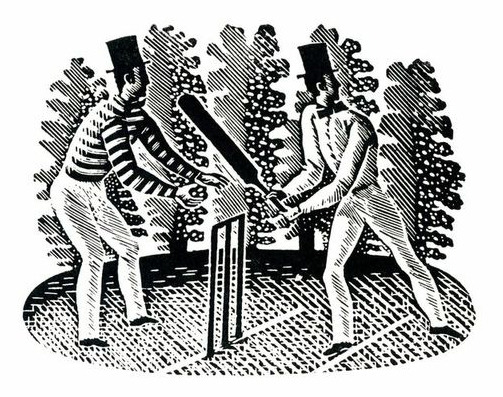
Woodcut design by Eric Ravilious by Wisden.
In 1938 typographer and spy, Robert Harling commissioned Eric Ravilious to produce an engraving for the Wisden Cricket Almanac. Harling knew Ravilious had a “special enthusiasm for the game” and wrote: “His engraving of mid-19th century batsman and wicket-keeper remains an ideal graphic introduction to one of England’s most durable publications.”
Over 75 covers have been published since 1938 with the Ravilious batsmen on the cover. The engraving briefly lost its cover-star status in 2003, when a photograph of Michael Vaughan relegated it to the spine of the book’s jacket, incurring the displeasure of traditionalists.
It was immediately restored to the cover in 2004, while staying on the spine as well. And so, for ten editions now, including this one, Ravilious’s creation has been more visible than ever.
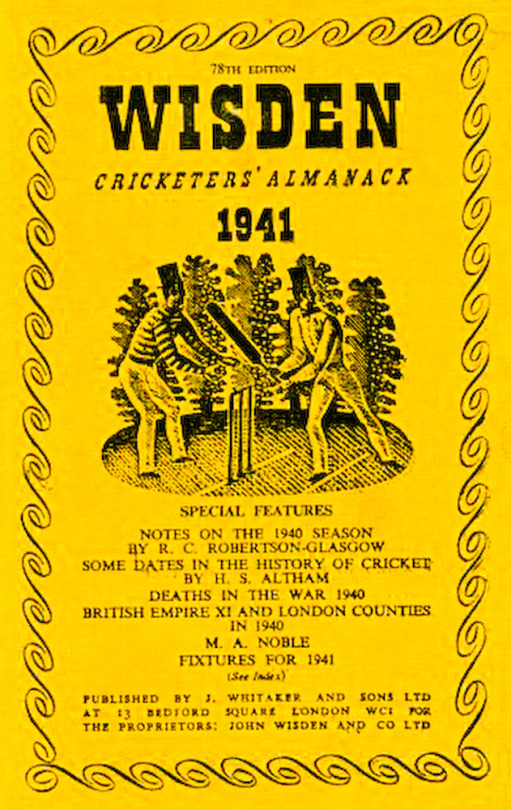
Whatever the origin, we do know for certain that Ravilious played cricket, if at a lowly level. In 1935, he wrote of turning out for the Double Crown Club, a dining club for printers and book designers, against the village team at Castle Hedingham in Essex, where he lived for a while. He said the game went on “a bit too long for my liking and I began to get a little absent-minded in the deep field after tea”. He made one not out in defeat, and bowled a few overs. “It all felt like being back at school, especially the trestle tea with slabs of bread and butter, and that wicked-looking cheap cake.” He went on to record the comment of the Double Crown captain Francis Meynell that his bowling was “of erratic length, but promising, and that I should have been put on before. Think of the honour and glory there.”
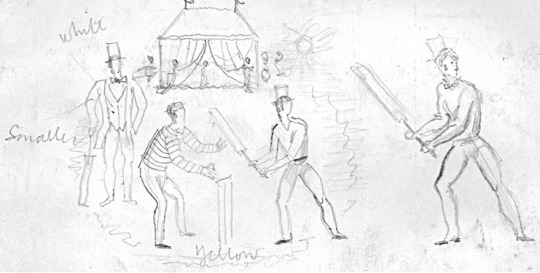
Sketch design by Ravilious for Wisden.
In another game at Castle Hedingham, with his wife Tirzah (a talented artist herself) “in charge of the strawberries and cream”, Ravilious talked of hitting three sixes. “It is, you might say, one of the pleasures of life, hitting a six.”
Ravilious saw only five of the Almanacks to carry his engraving. Yet his work — in many ways a distillation of Englishness — lives on.
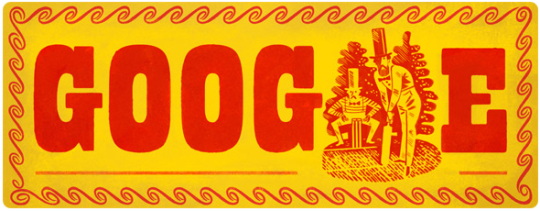
John Wisden’s 187th birthday by Google doodle – 5th September 2013.
PS: Before the second world war, Robert Harling taught at the Reimann School of Design in London, where one of his pupils was the young émigré Alex Kroll, later to join him as art director on House & Garden. A keen weekend sailor, Robert took part in the wartime evacuation of British forces at Dunkirk in May 1940, which he described in his book Amateur Sailor, published in 1944 under the pen name Nicholas Drew. The poet John Masefield praised the book as the best eyewitness account of Dunkirk ever written. Robert then joined the Royal Navy, first serving on mid-Atlantic convoy duty. Again, he gave a marvellous account of this experience in his atmospheric memoir The Steep Atlantick Stream (1946).
His friend Ian Fleming was responsible for Robert’s sudden transfer from anti-submarine warfare to the newly constituted Unit 17Z, given its name by Fleming himself and headed by Donald McLachlan. This small and, to Robert, highly congenial outfit, soon to be known as Fleming’s Secret Navy, was responsible for day-to-day liaison between the naval intelligence division and the British war propaganda teams.
Secret navy assignations, involving solitary missions to the US and the far and Middle East, appealed to the cloak-and-dagger instinct in Robert. The fastidious James Lees-Milne described him as “a rough diamond”. So, to some extent, he was. Wartime experiences cemented Robert and Fleming’s mutual admiration. Robert is depicted fondly in The Spy Who Loved Me as the make-up man on the Chelsea Clarion — “a man called Harling was quite a dab hand at getting the most out of the old-fashioned type faces that were all our steam-age jobbing printers in Pimlico had in stock.”

Cecil Buller (1886–1973) was a Canadian artist most notable for her wood engravings.
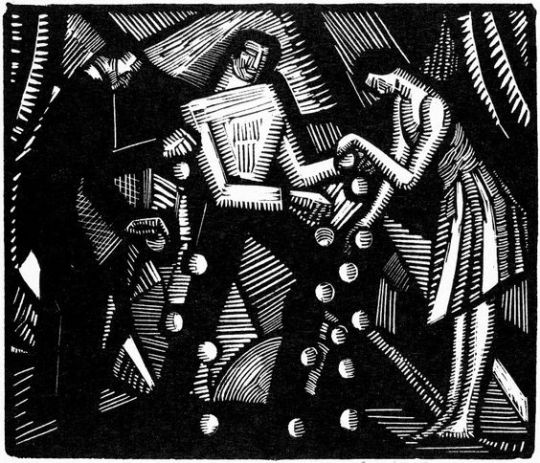
She was born in Montreal and travelled north America, and at 16 years old travelled Europe, mostly England and France. In 1910 She moved to New York where she attended the Art Students League in New York where her wood engravings started to get noticed. Then in 1912 she travels to Paris again where she would have been exposed to Cubists movment that had gained momentum at that time, this inspired the form of her woodcuts in the 1920’s.
She moved to London in 1916 to focus on graphic arts where she was educated under Noel Rooke, at the Central School of Art and Design. It was there that she met John Murphy, they married in 1917 and as an American he was able to move his new wife with him to Greenwich Village, New York in 1918.
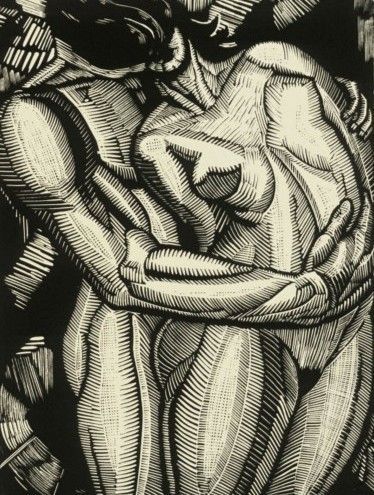
She gained success in the 20’s and 30’s for her wood engravings and were exhibited. In 1924 her only son was born, in 1930 an essay on her work was published in The Print Collector’s Quarterly. In 1937 she separates from her husband. From then on she travelled widely to Egypt, Iran, Greese, Afghanistan, and back and forth to London and Paris. In 1973 she died of a stroke.
She was awarded the Pennel Prize, Library of Congress, D.C. (1945), the Audubon Society Award (1947 and 1953) and the National Academy of Design Graphic Art Award (1949).